#victor signac
Explore tagged Tumblr posts
Text
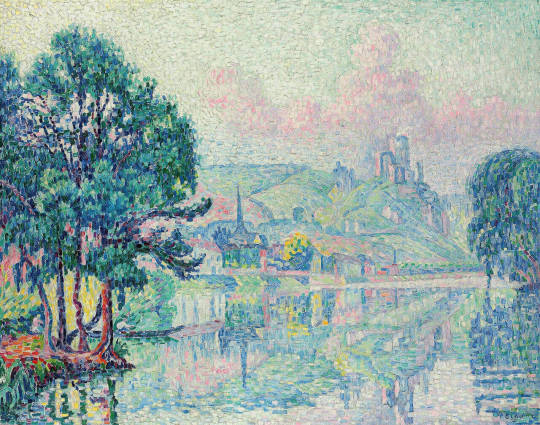
Les Andelys. Matin. Été (1923) | Paul Signac (1863-1935)
20 notes
·
View notes
Text
Une impressionniste oubliée sort de l’ombre au musée de Pont-Aven : Anna Boch
Arts et Expositions
Par Guy Boyer le 06.02.2024
Montée avec le musée d’Ostende, l’exposition consacrée à la femme peintre et collectionneuse Anna Boch (1848-1936) permet de découvrir cette figure méconnue de la période impressionniste et postimpressionniste venue en Bretagne en 1901 et 1912.
Premier événement à bénéficier de la générosité du musée d’Orsay en parallèle à l’exposition « Paris 1874. Inventer l’impressionnisme » (du 26 mars au 14 juillet), l’exposition « Anna Boch. Un voyage impressionniste » au musée de Pont-Aven, jusqu’au 26 mai, met au cœur de son parcours le Portrait d’Eugène Boch de Vincent Van Gogh (1853-1890) prêté par le musée parisien. Cette œuvre importante souligne les liens de cette famille belge avec l’avant-garde des années 1890 et leur goût de la collection.
Collectionneurs de Van Gogh, Gauguin, Marquet
L’exposition commence par la carrière de peintre d’Anna Boch, de ses débuts en Belgique jusqu’à ses voyages en Bretagne et dans le Sud de la France. Malgré certaines œuvres assez faibles, le corpus de cette artiste méconnue surprend par certains éclairs de génie et plusieurs emprunts à ses contemporains comme Segantini ou Valtat. Vient ensuite une section dédiée à ses différentes demeures et ses commandes à des artistes Art Nouveau comme Victor Horta (une réussite) et Maurice Denis (un échec). L’un des chapitres les plus passionnants reste celui consacré à ses collections artistiques puisqu’Anna Boch et son frère Eugène possédaient des Ensor, Gauguin, Van Gogh, Émile Bernard, Paul Signac, Henry Moret et Albert Marquet.
Une fortune de faïence
En Belgique, le père d’Anna Boch est célèbre car il est le fondateur de la société de faïencerie Boch frères (antenne belge de Villeroy & Boch). La famille vit confortablement dans le château de La Closière, près de La Louvière. Dès les années 1870, Anna Boch décore des plaques, plats et assiettes en camaïeu de bleus. Dans ces premières créations de céramique, on peut retrouver des traces de sa formation auprès d’Isidore Verheyden, un peintre de plein air (ne pas manquer son incroyable portrait par Anna Boch, où on le voit penché sur un tableau posé en biais).
Avec le groupe des XX
Dès 1885, Anna Boch rejoint le salon des XX, un cercle artistique fondé par son cousin Octave Maus, où exposent James Ensor et Jan Toorop mais aussi une quantité d’invités étrangers. C’est là qu’elle voit les dernières nouveautés artistiques, du divisionnisme de Segantini au pointillisme de Seurat. On reconnaît dans le travail d’Anna Boch une solidité de la composition (ici le reflet du bouquet de fleurs dans un miroir) et une harmonie des couleurs.
Une famille voyageuse
Aimant se déplacer facilement, Anna Boch achète une Minerva en 1907. On la voit ici, à bord de l’automobile, parmi les paysages du Midi de la France. Deux tableaux superposés permettent de comparer son style et celui de son frère. Devant un même paysage méditerranéen surmonté d’une tour sarrasine, on voit leurs approches différentes. Lui (en haut) schématise la composition, elle (en bas) joue des effets de matières et de couleurs. Même le chauffeur, Albert Lepreux, est de la partie et plante son chevalet avec eux dans la nature, de la Normandie au Maroc.
La Bretagne en deux temps
En 1901 et en 1912, la troupe sillonne la Bretagne. De Bénodet à Carhaix, Anna Boch en ramène des paysages maritimes. Aux plages des bords de l’Odet du premier séjour succèdent les falaises et rochers de la Bretagne du nord. Les grands formats panoramiques sont ensuite remplacés par des toiles au cadrage resserré.
Des commandes aux artistes
C’est l’architecte belge Art Nouveau Victor Horta qui restaure en 1895 la villa d’Anna Boch dans le quartier de Saint-Gilles à Bruxelles. Huit ans plus tard, la commanditaire déménage dans une maison construite par Paul Hermanus à Ixelles, où elle fait transporter le décor de Horta, cheminée comprise. Elle imagine également un grand décor qu’elle confie à Maurice Denis mais devant toutes les allégories antiques que celui-ci propose, elle préfère renoncer.
En pleine nature
L’exposition se conclue par une section plus faible consacrée aux liens d’Anna Boch avec le groupe de peintres luministes Vie et lumière. Les scènes bucoliques de ramasseurs de glands ou de ramendeuses de filets, qu’elle réalise alors, perdent en nervosité et en contrastes colorés. Pourtant, c’est l’époque d’une certaine reconnaissance publique en France puisqu’elle expose à la galerie Druet en 1908. Dans les années 1930, elle organise le devenir de ses collections, donnant plusieurs œuvres aux musées royaux des Beaux-Arts de Belgique ou au musée d’Ixelles.
https://www.connaissancedesarts.com/arts-expositions/impressionnisme/une-impressionniste-oubliee-sort-de-lombre-au-musee-de-pont-aven-11189177/
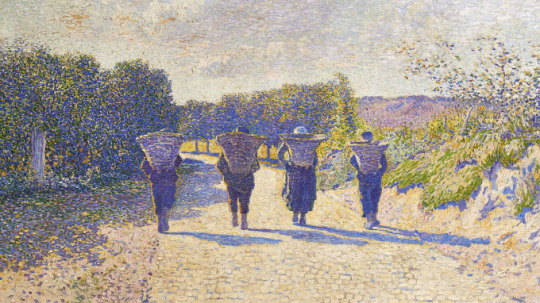

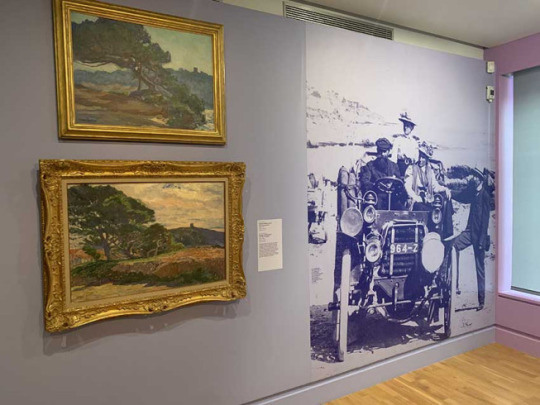
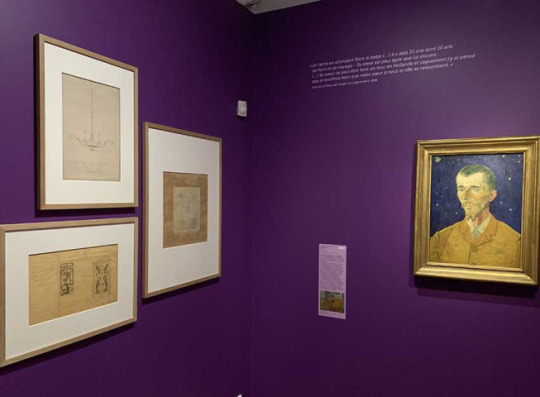


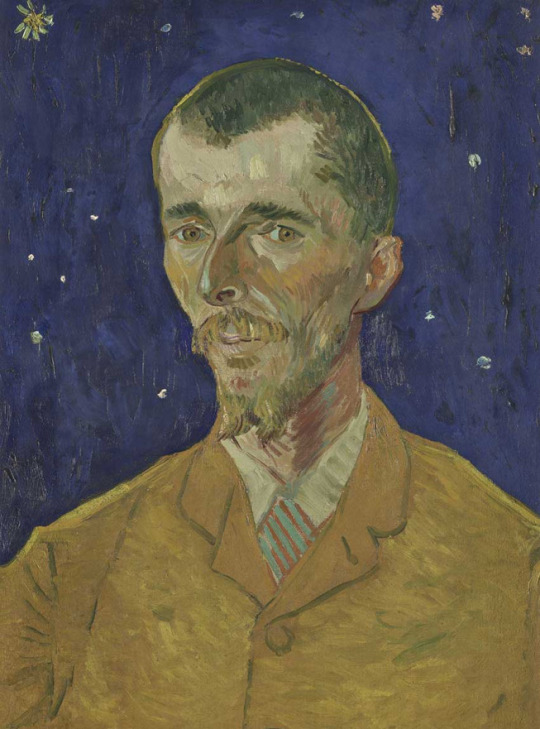
#france#brittany#breizh#bretagne#aesthetic#artists on tumblr#artistsoninstagram#artistsupport#meet the artist#painter#impressionistpainting#impressionistart#french impressionist#impressionistic#impressionism#orsay#louvre#met museum
0 notes
Text




PAUL VICTOR JULES SIGNAC WALL ART
Paul Victor Jules Signac (French: [pɔl siɲak]; 11 November 1863 – 15 August 1935) was a French Neo-Impressionist painter who, working with Georges Seurat, helped develop the Pointillist style. Paul Signac was born in Paris on 11 November 1863. He followed a course of training in architecture before deciding at the age of 18 to pursue a career as a painter after attending an exhibit of Monet's work. He sailed around the coasts of Europe, painting the landscapes he encountered. He also painted a series of watercolors of French harbor cities in later years.
#vintage#advertising#painting#oil on canvas#oil painting#drawing#sketching#watercolor#Port at sunset#seaport#sunset#signac#19th century#neo-impressionist#impressionist#sail#sailboats#ship#boat#landscape#coloring effects#village#gorgeous#pretty#nice#view#nature#natural#art#artist
1 note
·
View note
Text
Renowned Explorers Headcanon: Teams
Team 1
Leader: Anna Proskuriakova,
Members: Phailin Boonyasak, Phillipe Bensoussan
Team 2
Leader: Harry Walter
Members: Hojo Fumiaki, Jan-Piet Corneel
Team 3
Leader: Victor Signac
Members: Kiwi Paakariki, Maria Rodriguez
Team 4
Leader: Yvonne Lefevre
Members: Earl Shanty, Ivan Dashkov
Team 5
Leader: Suh Min-Jeong
Members: Molly Jones, Wang Yu
Team 6
Leader: Kwame Amanquatia
Members: Hatice Ataman, Hildegard Haas
Team 7
Leader: Bia Hekaton
Team members: Agatha von Brünswick, Dolores Garcia
Team 8
Leader: Pedrinho Pinheiro
Team members: Charles Templeton, Emilia Karwowska
#renowned explorers#anna proskuriakova#phalin boonyasak#phillipe bensoussan#harry walker#hojo fumiaki#jan-piet corneel#victor signac#kiwi paakariki#maria rodriguez#yvonne lefevre#earl shanty#ivan dashkov#suh min-jeong#molly jones#wang yu#kwane amanquatia#hatice ataman#hildegard haas#bia hekaton#agatha von brünswick#dolores gracia#pedrinho pinheiro#charles templeton#emilia karwowska
0 notes
Photo





Technical innovations and revivals, creative exploration in all mediums, and a growing market for all kinds of drawn and printed images helped define the nineteenth-century art world. This period witnessed the invention of lithography, a revival of etching, and the resurgence of the “painter-printmaker,” allowing artists to experiment with technique, color, and reproduction in new and revelatory ways. While some artists, like Edouard Manet, used printmaking as a means to popularize their paintings, others, like Henri de Toulouse-Lautrec, explored the possibilities of printmaking to produce original works of art.
Posted by Shea Spiller Paul Signac (French, 1863-1935). Harbour Scene, ca. 1894. Lithograph in six colors on wove paper. By exchange, 38.118 ⇨ Édouard Manet (French, 1832-1883). Lola de Valence, 1862-1863. Etching and aquatint on paper. Designated Purchase Fund, 77.164 ⇨ Charles Méryon (French, 1821-1868). Le Stryge, 1853. Etching on laid paper. Gift of Mrs. Charles Pratt, 57.188.31 ⇨ Hyacinthe-Louis-Victor-Jean-Baptiste Aubry-Lecomte (French, 1787-1858). Amazone, 1826. Chalk lithograph with chine colle, Designated Purchase Fund, 80.57.1 ⇨ Henri de Toulouse-Lautrec (French, 1864-1901). Miss Loïe Fuller, 1893. Color lithograph on wove paper. Museum Collection Fund, 39.25
#bkmworksonpaper#bkmeuropeanart#brooklynmuseum#brooklyn museum#brooklyn#european art#art hitory#nineteenth century art#paul signac#Édouard Manet#Charles Méryon#Hyacinthe-Louis-Victor-Jean-Baptiste Aubry-Lecomte#Henri de Toulouse-Lautrec#printmaking#lithograph#etching#aquatint#works on paper#colle#paper
30 notes
·
View notes
Text
Gothic, the French style.

The horrible images of Nôtre-Dame de Paris, the most famous cathedral in France and one of the most visited monuments in the worlds, burning down under the Parisian sky are still very vivid in our minds. When, on April 15th this year we saw that iconic, almost familiar, spire fell down on the ground, we all lost a piece of our hearts. Yes, either we are French or not, all around the world we felt the same void that day, because the arts, all of them, belong to all of us. They would be, with no doubt, the only worthy heritage we would leave if our race disappeared one day... so, seeing how vulnerable art can be in front of nature, made us feel quite insignificant, small, without purpose.

And I wonder how devastated the artists and writers who fell in love with that symbol of medieval Europe which is Nôtre-Dame would have felt by seeing it devoured by the flames. I am thinking about Victor Hugo, who made it the "main character" of one of his most celebrated novels, but also about the numerous painters who immortalised the cathedral in their works of art, of which Jean Fouquet (with "La Descente du Saint-Esprit" from "Livre d'Heures d'Étienne Chevalier", XV Century), William-Adolphe Bouguereau (with "La Bohémienne", 1890) and Paul Signac (with "Pont des Arts", 1925) are among the most famous ones. But, ultimately, I am thinking about who built the monument. All the masons, all the architects who, from 1163 (year when the choir and its two ambulatories started being built) to nowadays have contributed to make Nôtre-Dame "Nôtre-Dame", some of which actually saw it burn, around 1225-1230 (according to Eugène Viollet-le-Duc's findings, who also restored the cathedral in the 19th Century). April 15th, for them, would have seen their worst nightmare come true.
But, even though it might have sounded like that, this is not the main topic of this post, so let's go straight to the point, shall we?
When the first architects of Nôtre-Dame started their projects, they had to choose how to build the new cathedral that the Bishop of Paris, Maurice de Sully, ordered to erect in 1160. The bishop wanted a new church that could do justice to the prestige of his growing city. The population of Paris (just like many important medieval cities), in fact, saw a considerable rising in population from the XI to the XII centuries, due to many factors, such as an established economic stability and new technologies. De Sully chose a pre-existing site for the new church (the site in the past had already been a Gallo-Roman temple during the Roman occupation, a paleochristian church in the IV century, a Merovingian basilique, a Carolingian cathedral and, finally, a Romanesque cathedral) and, in order to have the big, shiny, monumental cathedral he wanted, he chose for it a new style that was emerging in those years in that same region.
We are obviously talking about the Opus Francigenum, better known as Gothic architecture.

This style, named "Gothic" for the first time in the XVI by Italian humanist Giorgio Vasari to indicate a Nordic, barbaric and in general opposed to the symmetrical classicism of the Renaissance echoing the Greek and Roman times, characterised the last centuries of the Middle Ages. Vasari was actually right, because the Gothic was the first completely original architectural style since the Greek one and, in fact, it was the first style to break out the oppressive chains of the past. Plus, Gothic architecture is probably the only architectural style in the world to have a creator, with a place and a date of birth, which will make us easier to tell its story.
The place is the Basilique de Saint-Denis. The year is 1144 circa and the creator is abbot Suger.

In his life, Suger was the prime minister of the kings Louis VI and Louis VII, and he was already the abbot of Saint-Denis, a commune in the northern suburbs of Paris, in the Île-de-France region, when he decided, around 1135 to renovate the choir, the capocroce and the nartex of the Saint-Denis basilica in order to enlighten the prestige of what had been the burial place of French monarchs since the 10th century, and literally, since light, height and lightness are the key words when it comes to Gothic buildings.

"Now that the new posterior part was linked to the anterior one, the church shines forth in the middle. Living light, in fact, brightens what luminously joins what is bright. And bright is the noble edifice pervaded by new light"
With these words, Suger describes his love for the word "light" and all of its synonyms, but he also outlined the aesthetic of the new style he had just invented. So, in the Basilique of Saint-Denis, he built a nartex with two towers and a decorated rose window in the middle, the first of the kind, and the equivalent of a bomb of light exploded into a building for the first time. Light really was the main character of this Opus. Suger's conception of God seen as transcendental light derives from the writings of John the Scot, but even more importantly, of Denis Areopagus, which was often mistaken with Saint Denis, the first bishop of Paris. Denis Areopagus merged the Christian teachings with the Plotinus' neoplatonic philosophy, which said that the multiple aspects of life were dictated by the "One". Denis, thus, wrote that "this stone or that piece of wood are light, for me, because all the visible things are "material lights".
From that time on, though, everywhere in France and then in Europe, the pointed arch substituted the round arch of the Romanesque, the walls became to disappear more and more, making way to large windows which could be invaded by divine light, the buildings became taller and taller, thanks to a sophisticated game between rampant bows and buttresses.
In France, the Gothic style eventually evolved into the rayonnant style first and in the flamboyant style then, before spreading everywhere in Europe, especially in Germany and England, but also in Italy and in Spain, but, since this is not intended to be an architecture lesson, I will not delve further into the argument (at the moment). What is actually crucial for us to know right now is that, with the Gothic revolution, the face of Europe changed forever in a way that only the Romans and the Greeks before them could do, and that this revolution began in the actual land of revolutions.
France.
#france#francia#gothic#gothique#gotico#gothic architecture#architecture gothique#architettura gotica#nôtre-dame de paris#nôtre-dame#notre-dame#saint-denis#victor hugo#jean fouquet#william-adolphe bouguereau#paul signac#eugène viollet-le-d#suger#art#arte#architecture#architettura#architecture history#histoire de l'architecture#storia dell'architettura#history#histoire#storia#ucrart
11 notes
·
View notes
Text
Birds of Prey - Inspirations
Chinami:

Ruth "Blindfold" Aldine - Marvel Comics
Madame Xanadu - DC Comics
Theresa - Fable
Chihaya Mifune - Persona 5
Death - Sandman
Joanne - Queen of Thieves
Kira:

Vancey Fioré - Valkyria Chronicles 4
Eiger - Shadowrun: Dragonfall
Olivia Benson - Law & Order: SVU
Victor Signac - Renowned Explorers
Clare - Claymore
Kira - Queen of Thieves
Taria:

Kasumi Goto - Mass Effect
Nami - One Piece
Ann Takamaki - Persona 5
Rouge the Bat - Sonic the Hedgehog
Fujiko Mine - Lupin the III
Thalia - Queen of Thieves
#hypnosis mic#hypnosis microphone#hypmic#hypnosis mic oc#hypmic oc#chinami chinen#kira chinen#taria chinen#birds of prey#inspirations
8 notes
·
View notes
Photo

The Boats, Paul Signac, 1895, MoMA: Drawings and Prints
Gift of Victor S. Riesenfeld Size: composition: 9 3/8 x 15 3/4" (23.8 x 40 cm); sheet: 16 x 20 7/8" (40.7 x 53.1 cm) Medium: Lithograph
http://www.moma.org/collection/works/67807
8 notes
·
View notes
Photo

The Boats, Paul Signac, 1895, MoMA: Drawings and Prints
Gift of Victor S. Riesenfeld Size: composition: 9 3/8 x 15 3/4" (23.8 x 40 cm); sheet: 16 x 20 7/8" (40.7 x 53.1 cm) Medium: Lithograph
http://www.moma.org/collection/works/67807
8 notes
·
View notes
Photo

Paul Victor Jules Signac (France 1863 – 1935)
Place des Lices, 1893
Oil on canvas, Carnegie Museum of Art
84 notes
·
View notes
Photo

PAUL VICTOR JULES SIGNAC
On this day of 11th November, Paul Victor Jules Signac (11 November 1863 – 15 August 1935) was born in Paris.
He was a Neo-Impressionist painter who, working with Georges Seurat, helped develop the Pointillist style.
Signac experimented with various media as oil paintings and watercolors, etchings, lithographs, and many pen-and-ink sketches.
Signac studied a course in architecture before, but at the age of 18, he decided to pursue a career as a painter. He sailed on the Mediterranean Sea, visiting the coasts of Europe and painting the landscapes he encountered. He also painted a series of watercolors of French harbour cities.
In 1884 he met Claude Monet and Georges Seurat. He was struck by the systematic working methods of Seurat and by his theory of colors and he became Seurat's faithful supporter, friend, and heir with his description of Neo-Impressionism and Divisionism method. Under Seurat's influence he abandoned the short brushstrokes of Impressionism to experiment with scientifically-juxtaposed small dots of pure color, intended to combine and blend not on the canvas, but in the viewer's eye, the defining feature of Pointillism.
Paul Signac, Albert Dubois-Pillet, Odilon Redon, and Georges Seurat were among the founders of the Société des Artistes Indépendants. The association began in Paris on 29 July 1884 with the organization of massive exhibitions, embracing as their motto, "Neither jury nor awards" (Sans jury ni récompense). "The purpose of Société des Artistes Indépendants—based on the principle of abolishing admission jury—is to allow the artists to present their works to public judgement with complete freedom". For the following three decades their annual exhibitions flourished and set the trends in the art of the early twentieth century.
As president of the Société des Artistes Indépendants, from 1908 until his death, Signac encouraged younger artists by exhibiting the controversial works of the Fauves and the Cubists. He was the first patron to buy a painting by Matisse.
Signac served as a juror with Florence Meyer Blumenthal in awarding the Prix Blumenthal, a grant given between 1919 and 1954 to painters, sculptors, decorators, engravers, writers, and musicians.
Paul Signac died from sepsis in Paris on 15 August 1935 at the age of 71. His body was cremated and was interred three days later, on 18 August, at the Père Lachaise Cemetery.
8 notes
·
View notes
Photo

Fransız Gotik Mimarisi'nin en iyi örneklerinden biri olarak kabul edebileceğimiz Notre-Dame Katedrali'nin yapımına 1163 senesinde başlanmış ve büyük bir bölümü 1225-1250 seneleri arasında tamamlanmış, katedralin tamamı ise 1345 senesinde bitmiştir. 1790larda Fransız Devrimi esnasında alacağı ciddi zararlara kadar yüzyıllar içerisinde yenilenen ve değiştirilen bu yapı, 1800lere kadar yıkık kalmış fakat sonra tekrardan inşa edilmiştir. 1802 senesinde Katolik Kilisesi'ne dönüşen bu yapı, 1831 senesinde Victor Hugo 'The Hunchback of Notre-Dame' (Notre-Dame'ın Kamburu) isimli romanını yazana kadar çürümeye devam etmiş, romanın ses getirmesinden sonra insanlar bu yapıya önem vermeye başlamış ve Fransız Hükümeti yapıyı inşa etmesi için mimarlar atamıştır. 15 Nisan 2019 tarihinde çıkan yangın yaklaşık beş yüz itfaiyeci tarafından söndürülmüş, haberlere göre halkın koridor oluşturarak eserleri kurtardığı ve yaklaşık olarak 600-700 milyon euronun katedralin restorasyonu için bağışlandığı haberleri bulunmakta ve ayrıca ellerinde yer alan planlara göre katedralin tekrardan yapılabileceği fakat bunun için zamana ihtiyaç olduğunu söylemektedirler. 1991 senesinden beri UNESCO'nun 'Dünya Mirası' listesinde yer alan Notre-Dame'ı alevler içinde görmek ne kadar üzücü olsa da içerisinde yer alan vitray pencereler, cephe ve desteklerin kurtarıldığı haberini almak mutluluk verici.. Farklı sanatçıların gözünden Notre-Dame'ı görebilmek için ➡️➡️ 1- Miquel Utrillo - View of the apse of Notre Dame Paris, in the show / 2- Paul Signac - Le Pont des Arts / 3- Amrita Sher-Gil - Notre Dame / 4- Thomas Girtin - View of the Pont de la Tournelle & Notre Dame taken from the Arsenal / 5- Edward Clark - Paris Essay / 6- Dordio Gomes - Cais da Farinha, Paris / 7- Maximilien Luce - Notre Dame de Paris & The Quai Saint-Michel and Notre Dame / 8- Wilhelm Cornelis Bauer - Interieur van de Notre-Dame te Parijs / 9- Pascal Lemaitre - Notre-Dame de Paris Cathedral / 10- Henri Rousseau - Notre-Dame #notredame #notredamedeparis #notredamedepariscathedral #building #architecture #sanat #mimarlık #art #worldheritage #dünyakültürmirası #unesco #benibunaannemzorladi (at Cathédrale Notre-Dame de Paris) https://www.instagram.com/benibunaannemzorladi/p/BwWvwSAAKh5/?utm_source=ig_tumblr_share&igshid=1vumi9pduc2s7
#notredame#notredamedeparis#notredamedepariscathedral#building#architecture#sanat#mimarlık#art#worldheritage#dünyakültürmirası#unesco#benibunaannemzorladi
1 note
·
View note
Text
#UnDíaComoHoy: 11 de noviembre en la historia
El 11 de noviembre es el día 315º día del año. Quedan 50 días para finalizar el año. Estos son algunos de los eventos más destacados que ocurrieron un día como hoy 11 de noviembre.
-1821: nace Fiódor Dostoyevski, escritor ruso. Uno de los principales escritores de la Rusia Zarista, cuya literatura explora la psicología humana en el complejo contexto político, social y espiritual de la sociedad rusa del siglo XIX. Es considerado como uno de los más grandes escritores de occidente y de la literatura universal.
-1863: nace Paul Victor Jules Signac, pintor neoimpresionista francés famoso por su técnica puntillista.
-1911: nace Roberto Matta, arquitecto, pintor, filósofo y poeta chileno. Considerado el último de los representantes del surrealismo.
-1918: a las 11 de la mañana, en un vagón de tren, improvisado cuartel general del mariscal francés Ferdinand Foch, en el bosque de Compiégne, cerca de París (Francia), se firma el armisticio que pone fin a la más terrible guerra jamás conocida por la Humanidad: la Primera Guerra Mundial. Cuatro días antes, el jefe de la delegación alemana, Mathias Erzberger, partió en coche de las líneas alemanas, llevando una hoja de papel en blanco con la firma al pie del canciller alemán, con instrucciones de aceptar, in extremis, las condiciones que fuesen, pero evitando en lo posible una humillación para el Ejército del Káiser. El pasado día 9, cuando Erzberger ya conocía las condiciones aliadas que equivalían a una rendición total, se enteró de la caída del emperador Guillermo II y su imperio, y su cambio por una República presidida por el socialdemócrata Friedrich Ebert. Guillermo II se exilia en los Países Bajos.
-1926: en Estados Unidos, se inaugura la Ruta 66. Una de las rutas federales originales, la U.S. 66 se estableció este día, aunque no se señalizó hasta el año siguiente. Originalmente discurría desde Chicago (Illinois), a través Misuri, Kansas, Oklahoma, Texas, Nuevo México, Arizona y California, hasta finalizar en Los Ángeles con un recorrido total de 2.448 millas3 (3.939 km).
-1928: nace Carlos Fuentes, escritor mexicano. Uno de los autores más destacados de su país y de las letras hispanoamericanas, autor de novelas como La región más transparente, La muerte de Artemio Cruz, Aura y Terra Nostra y ensayos como La nueva novela hispanoamericana, Cervantes o la crítica de la lectura, El espejo enterrado, Geografía de la novela y La gran novela latinoamericana, entre otros.
-1942: en la Segunda Guerra Mundial, los nazis invaden Vichy (en el sur) y completan la invasión de Francia.
-1950: nace Jim Peterik, músico y letrista estadounidense de Survivor.
-1951: en Argentina, las mujeres votan por primera vez. Evita Perón lo hace por primera y última vez (enferma de cáncer).
-1960: nace Stanley Tucci, actor, director, productor y escritor estadounidense, ganador en dos ocasiones del Premio Emmy, del Globo de Oro y nominado al Óscar. Entre sus trabajos más conocidos están Lucky Number Slevin, Camino a la perdición, La terminal, El diablo viste de Prada y Desde mi cielo.
-1962: nace Demi Moore, actriz estadounidense. Después de papeles pequeños en películas y un papel en General Hospital, Moore estableció su carrera en películas como St. Elmo’s Fire, Ghost, A Few Good Men, Indecent Proposal y Disclosure. Moore tomó su nombre profesional de su primer esposo, el músico Freddy Moore, y es madre de tres hijas de su segunda matrimonio con Bruce Willis. Se casó con su tercer esposo, el actor Ashton Kutcher, en 2005, y se divorció de él en 2011.
-1964: nace Calista Flockhart, es una actriz estadounidense, conocida por protagonizar la serie Ally McBeal (1997-2002) y por su papel en la serie Brothers and Sisters (2006-2011). Está casada con el también actor Harrison Ford.
-1968: se declara la segunda república de las Maldivas.
-1974: nace Leonardo Di Caprio, actor estadounidense. Ha recibido numerosos premios, entre ellos un Óscar al mejor actor por su interpretación en El renacido, un Globo de Oro al mejor actor en drama por su actuación en El aviador en 2004 y en 2013 un Globo de Oro al mejor actor en comedia o musical por El lobo de Wall Street, entre otros reconocimientos. Adicionalmente, ha ganado el premio Oso de Plata y un Chlotrudis. DiCaprio comenzó su carrera apareciendo en comerciales de televisión antes de actuar en roles recurrentes en series de televisión como en Santa Bárbara y Los problemas crecen a principios de los años 1990. Hizo su debut fílmico en la comedia de ciencia ficción y terror Critters 3 en 1991 y recibió elogios de la crítica por su actuación en Vida de este chico, en 1993. DiCaprio obtuvo reconocimiento por sus trabajos posteriores en papeles como en ¿A quién ama Gilbert Grape? (1993) y La habitación de Marvin (1996), así como en papeles principales en Diario de un rebelde (1995) y Romeo + Julieta (1996), antes de alcanzar la fama mundial por la película de James Cameron de 1997, Titanic.
-1975: nace Angélica Vale, actriz, comediante y cantante mexicana. Hija de Angélica María y Raúl Vale.
-1992: la Iglesia Anglicana aprobó la ordenación de las mujeres, tomando considerando que El Nuevo Testamento habla de cómo las mujeres atendían al ministerio de Jesús (cf. Lc 8,2-3), así como de las funciones importantes que tenían algunas mujeres en las Iglesias a las que Pablo dirigía sus cartas (Rom 16,1-12; Flp 4,3). A pesar de ello, la Iglesia católica romana y las Iglesias ortodoxas actualmente siguen manteniendo el uso antiguo de ordenar solamente a los varones para el sacerdocio, posición reafirmada por los ortodoxos en la «Declaración de Atenas del año 1978″ de la Comisión doctrinal mixta anglicanoortodoxa y la Congregación romana para la doctrina de la fe, en la cual se establecía que para el sacerdocio sólo podían postularse personas del género masculino.
-2004: muere Yasser Arafat, con este hecho Mahmoud Abbas se convierte en el nuevo líder por la Liberación de Palestina.
-2006: en Japón, sale a la venta la tercera consola de sobremesa de Sony, la PlayStation 3.
-2010: muere Dino De Laurentiis, productor de cine italiano (n. 1919). Reconocido internacionalmente por las numerosas películas exitosas de su historial. Algunas de producción italiana han llegado a obtener el rango de película de culto, como Arroz amargo (1946), La strada (1954) y Las noches de Cabiria (1956), y otras creadas con equipos internacionales han sido grandes éxitos, como Guerra y paz (1956), Barrabás (1962), Barbarella (1968), Serpico (1973), Conan el Bárbaro (1982), Terciopelo azul (1986) y varias películas de la saga sobre Hannibal Lecter.
La entrada #UnDíaComoHoy: 11 de noviembre en la historia aparece primero en culturizando.com | Alimenta tu Mente.
1 note
·
View note
Text
POINT
Before beginning working with point myself, I decided to research into successful artists who use point/pointillism to create pieces of art.
The first artist I looked at is, Paul Victor Jules Signac. He was a French Neo-Impressionist painter who, while working with Georges Seurat, helped develop the Pointillist style. When looking at his style I found it really interesting, the texture that the pointillism creates is almost as if it is collage using lots of different colours. The colour in itself is fascinating as it includes bold colours where they would not normally be used, such as bright orange, purple and pink.

The second artist I looked at is, Jerry O Wilkerson. He is a St Louis-based artist, Wilkerson expertly blended pointillism with pop art in his work. Most of his subjects being food-based, featuring hamburgers, hot dogs, and even a Campbell's soup tin, which he depicted using point and vivid colours. The vivid colours and point make the photo look grainy and old fashioned, this is highly interesting as it still represents a pop art style.

Finally I looked at William Wilkins. He graduated from the Royal College of Art in 1960, after this Wilkins started developing his own pointillist technique in the 1970s. His earlier works seem to be focused on tone and colour and frequently use many layers of paint, while his more recent work is less interested in layering and more in the opacity of single layers. His style of pointillism is more realistic than the others that I have researched into.

0 notes
Photo

Paul Signac - Port-en-Bessin, a Cliff
Paul Victor Jules Signac (1863-1935) was a French Neo-Impressionist painter who, working with Georges Seurat, helped develop the Pointillist style.
13 notes
·
View notes
